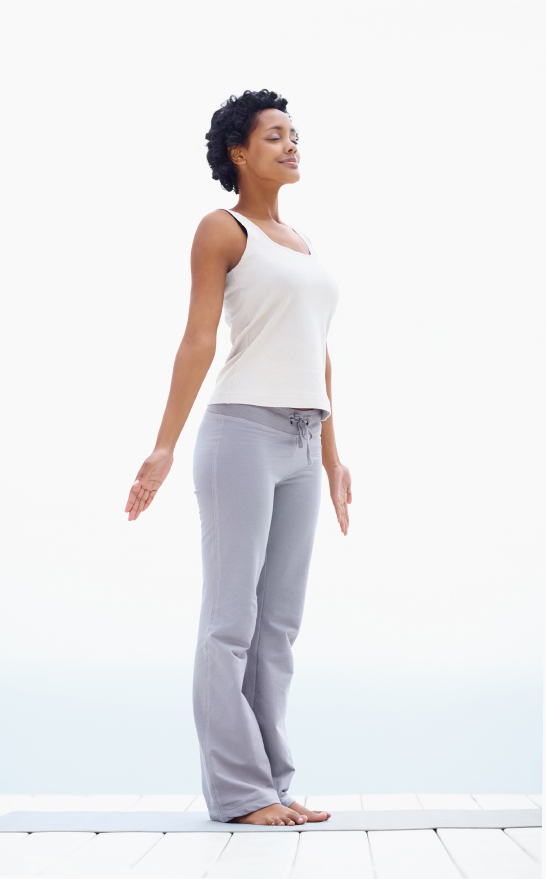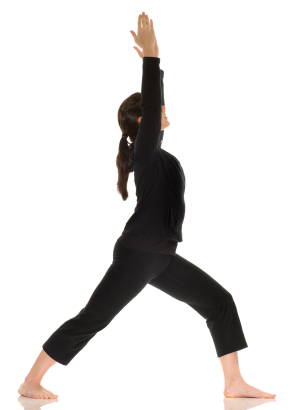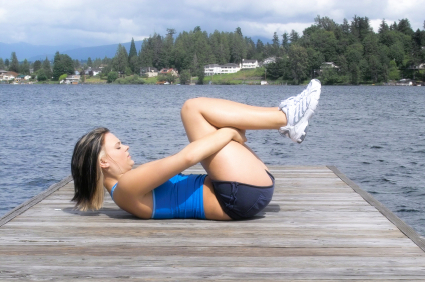By Stephen T. Sinatra, M.D., F.A.C.C., F.A.C.N., C.N.S., C.B.T.
Some things lose their appeal with time. They get old. Stale. Out-of-fashion. Yoga is definitely not one of them. This wonderful form of exercise and relaxation goes back about 5,000 years ago to ancient India, but only began to be taught in the West about a century ago.
5 simple moves to get you started!
Ever since the days when I was first training as a cardiologist, I’ve been an advocate of yoga. I first became interested in it when the practice became popular in the 1960s and 1970s. At the time, there was little scientific validation for its health benefits. Not anymore. Today yoga is backed by hundreds of positive studies that are literally pouring out as modern day researchers validate the ancient wisdom.
One recent study put a big smile on my face. It was a comprehensive review of several dozen previous studies on the effects of yoga on cardiovascular disease risk factors. After analyzing the data from forty-four studies and more than three thousand participants, the German researchers confirmed improvements in blood pressure, heart and respiratory rates, waist circumference, blood lipids, blood sugar, and insulin resistance. (See Cramer H, et al. below)
The participants in those studies included healthy subjects, non-diabetic individuals with high risk, and diabetics. The analysis “revealed evidence for clinically important effects of yoga on most biological cardiovascular risk factors,” the authors concluded, adding that yoga should be considered as a beneficial activity in both the general population and for patients at risk. The yoga effects, they said, “were comparable or superior” to those of official guideline-endorsed interventions like exercise and psychological therapy.
Over the years, I’ve seen yoga help many patients with their cardiovascular health, blood pressure, anxiety, depression, lower back problems, arthritis, and even digestion. And that’s why I have often recommended it to my patients and even participated in yoga seminars to inspire people to start the practice.
So if you have had any reservations about getting into yoga – whether you are young or elderly – put those reservations aside and just get with it.
You’ll be glad you did. You’ve got much to gain and nothing to lose.
To help you make the transition, I asked a leading expert − Larry Payne, Ph.D., one of the foremost yoga teachers in the country. Dr. Payne is the co-founder of the International Association of Yoga Therapists, a group for professionals who teach yoga to individuals with medical or physical limitations. He also co-developed the yoga curriculum at the UCLA School of Medicine and is a co-author of Yoga for Dummies (John Wiley & Sons, 2014) and Yoga Rx (Broadway, 2002).
Dr. Payne suggests five basic poses that he regards as the “most user-friendly” for individuals – including seniors − who want to ease their way into yoga. I’ve included pictures and descriptions of each one. They are great choices.
Proper Breathing Maximizes Benefits
To “do” yoga the right way requires learning what is called “yoga breathing.” That means breathing purposefully through the nose—you inhale and pause for a moment, then you exhale and pause for a moment, usually in conjunction with a specific movement.
“The yogis say that the nose is meant for breathing and the mouth is meant for eating,” says Dr. Payne. “We take this advice seriously.”
The focus on breathing is what helps make yoga a mind-body practice. Every muscle and organ in your body is connected to the brain by nerves. By simply relaxing your mind you relax all of these places. When you change your breath as you do in yoga you change your mood. The breath is longer and slower than normal. You oxygenate the system. You warm and filter the air through your nose. You’ve heard people say to take a few deep breaths when you are upset. There is good reason for that. When you breathe this way, and perform the poses correctly, with your mind in the moment, “it is like sending an email to your nervous system to relax,” says Dr. Payne. “It puts you in a better mood and increases the sense of wellbeing.”
Let’s Start! Five Poses for Beginners
Do not force any of these poses. If a pose doesn’t feel comfortable, adjust it or skip it. In the beginning, hold the poses for about 30 seconds unless otherwise noted, and work up slowly to about a minute. Perform them in the following order:
Tadasana (Mountain)
What to do: Stand comfortably with your feet about 4–6 inches apart, toes pointed forward. Look straight ahead and stand tall (align your ears with the middle of your shoulders, hips, knees, and ankles). One way to make sure you’re doing this correctly is to stand with your back against a wall. Once you are in position, start your yoga breathing. The position will remind you about the importance of good posture at a time in life when many people unconsciously start bending forward.
Benefit: Helps shift you from your current state of mind to the more settled mind-body mode of yoga.
Vira bhadrasana (Warrior)
What to do: Start in the mountain pose, but rotate your left foot outward a quarter turn and extend your right arm forward until it is parallel to the floor. Take one big step forward with your right foot so that your foot is beneath your outstretched hand. Then place your hands on your hips. With your back straight, bend your front knee. You should be able to see your toes. If you can’t, gently extend your foot a little further. Now straighten the leg, let your arms hang to your side, and inhale.
While breathing in, bend the front knee again and raise both arms over your head. Then, as you exhale, slowly bring your arms back down to your sides and straighten your knee. Repeat this motion three times. On the third repetition, hold the posture for about 6–8 breaths, which is about 30 seconds. Repeat the same movement with the other side of your body.
Benefit: Many people experience more problems on one side of the body than the other. This maneuver helps fortify balance and stability, opens the chest, and strengthens the joints.
Bhujangasana (Cobra)
What to do: Consider for a moment your habitual tendency to slump forward during daily activities. It happens everywhere: on the toilet, in the kitchen, at the computer, watching TV. Most people need to arch their backs to compensate for this chronic forward tilt, and the cobra pose does just that.
To begin, lie on your stomach with your legs slightly separated. Turn your heels out and point your toes in. Bend your arms so your hands are beside your shoulders, and your palms are against the floor. Keep your elbows tucked close to your sides and drop your shoulders. As you inhale, lift your head and torso upward as high as you can while still keeping your hips on the floor. Don’t lift the hips. Keep your buttocks loose. As you exhale, come back down to the starting position (this is one position that you do not want to hold at the top). Perform this movement 6–12 times according to your ability. If you cannot raise yourself all the way up in the manner described, try using your forearms for support—just be sure to keep them flat on the ground.
Benefit: You are pumping the vertebral discs in your lower back that are pushed the wrong way all day. This is a way to help bring your lower spine back into its natural curve. The pose can often help with disc and sciatica problems.
Apanasana (Knees to chest)
What to do: Roll onto your back. Bring your knees up and into your chest. Place each hand on the side of the leg just below the knee as if to gently hold the knee inward. If you have knee problems, hold underneath your thighs for added stability. In apanasana, you can do any one or several movements: just hold the knees, squeeze them closer to the chest in and out, gently rock back and forth, or rock laterally in each direction.
Benefit: After the arching of the back in the cobra pose, the apanasana relaxes the lower back and acts like a massage.
Shavasana (Corpse)
What to do: Lie on your back. Legs are normally straight with the feet naturally turned out. Hands are at your sides, palms up. If you have a lower back problem, bend the knees instead of having them straight. Stay in the position for three to five minutes. Put your awareness on the breath. After doing this position regularly for a while, increase the time to 15-20 minutes. As you lengthen the time it becomes like a meditation. You may think you are doing nothing with this pose but you’ll be surprised. It is a very underestimated pose. This is, in fact, the most popular of all yoga poses, and the most used in yoga therapy.
Benefit: Relaxes the body and mind, and helps people discover the essence of yoga: a quiet mind.
Your Next Step
If you enjoy the simple yoga routine laid out here, Dr. Payne offers a great seven-disc DVD series called Yoga Therapy Rx for people who he respectfully refers to as “in the prime of life.” You can learn more by calling his yoga center in Santa Monica at 310-306-8845, or at his web site, www.samata.com.
Dr. Payne is quick to point out, and I totally agree, that your best bet is to learn yoga from an experienced teacher. Group classes are available most everywhere − at gyms, spas, and yoga centers − and usually cost around $10–18 per session. Individuals with special needs should look for a certified yoga therapist who can create a safe and effective routine. People with pronounced limitations can even practice yoga while sitting in a chair. To find a yoga therapist in your area, visit www.iayt.org. Private instruction runs from $75 to $150.
References:
- Cramer H, et al. Effects of yoga on cardiovascular disease risk factors: A systematic review and meta-analysis. Int J Cardiol. 2014. 173(2):170-183.
- Sinatra, Stephen T. Lower Your Blood Pressure In Eight Weeks (Ballantine Books, 2003)
- Larry Payne, PhD’s web site: www.samata.com
- Payne, Larry & Feuerstein, Georg. Yoga for Dummies (John Wiley & Sons, 2014)
- Payne, Larry & Usatine, Richard P. Yoga Rx (Broadway, 2002)
- www.iayt.org















